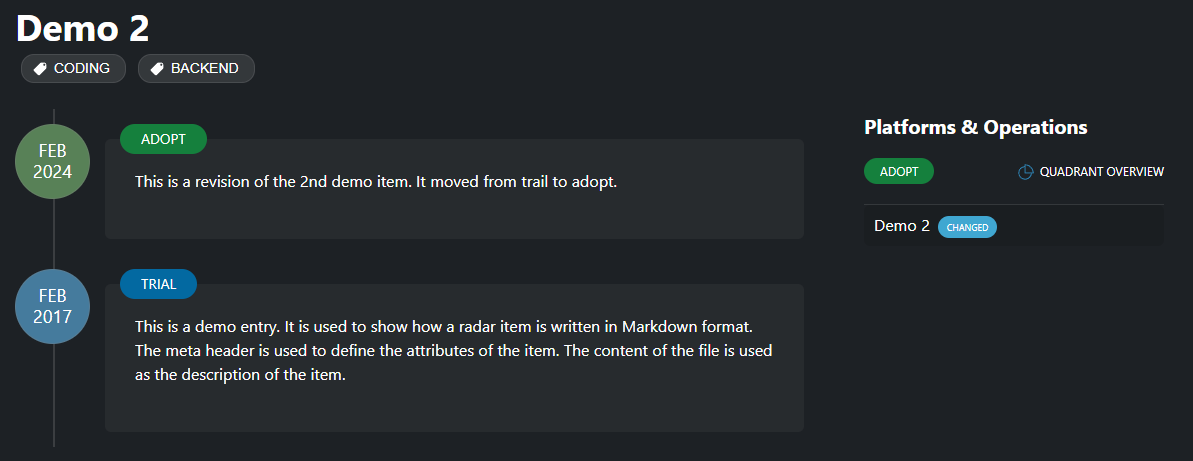Interpreting Items
This page explains how to understand and interpret the technology items displayed on the Tech Radar for Compass.
Item Representation
Technologies on the radar are represented as “blips” - small shapes positioned in the appropriate quadrant and ring.
Blip Shapes
The shape of a blip indicates its status:

- Circle - Unchanged status since the last radar update
- Triangle - New or moved since the last radar update (has the “new” or “changed” flag)
- Diamond - Recently changed in the most recent radar update
Blip Colors
The color of a blip typically corresponds to its quadrant:
- Each quadrant has its own color (configurable by administrators)
- This makes it easier to visually associate blips with their quadrants
Blip Position
The position of a blip indicates:
- Quadrant - The category the technology belongs to
- Ring - The adoption stage of the technology
- Clustering - Similar or related technologies may be positioned near each other
Item Details
When you click on a blip or item in the list, you’ll see detailed information about the technology.

Basic Information
The basic information includes:
- Name - The name of the technology
- Quadrant - The category it belongs to
- Ring - Its current adoption stage
- Status - Whether it’s new, changed, or unchanged
Description
The description provides:
- An explanation of what the technology is
- Its key features and benefits
- Use cases and applications
- Potential limitations or considerations
History
The history section shows:
- How the technology has moved between rings over time
- When changes occurred
- Previous descriptions or assessments
This historical context helps you understand the evolution of the technology within your organization.
Tags
Tags provide additional categorization:
- Technologies may have multiple tags
- Tags can represent use cases, platforms, languages, etc.
- Tags are clickable to filter the radar by that tag
Status Flags
Status flags indicate the state of items on the radar:
New Flag
The “new” flag indicates:
- The technology has been added to the radar in the current version
- It’s appearing for the first time
- It’s worth paying attention to as a new addition
New items are typically represented by triangles on the radar.
Ring Interpretation
Understanding what each ring means is crucial for interpreting the radar:
Adopt Ring
Technologies in the Adopt ring:
- Are proven and mature
- Have been successfully used in production
- Are recommended for use in new projects
- Have organizational support and expertise
Trial Ring
Technologies in the Trial ring:
- Show promise and potential value
- Have been tested in limited contexts
- Are worth exploring in projects
- May have some limitations or unknowns
Assess Ring
Technologies in the Assess ring:
- Are worth exploring to understand their impact
- Are not yet ready for production use
- Require investigation and evaluation
- May be emerging or evolving rapidly
Hold Ring
Technologies in the Hold ring:
- Should be avoided for new projects
- May be legacy technologies being phased out
- Could have security, performance, or support issues
- Might be replaced by better alternatives
Making Decisions
When using the radar to inform technology decisions:
- Consider the quadrant - Is this the right type of technology for your needs?
- Check the ring - Is this technology recommended for use?
- Read the description - Understand the context and considerations
- Review the history - See how the assessment has changed over time
- Look at related technologies - Are there alternatives in more favorable rings?
The radar is a guide, not a mandate. Use it alongside other factors like team expertise, project requirements, and business context when making technology decisions.